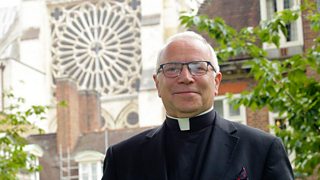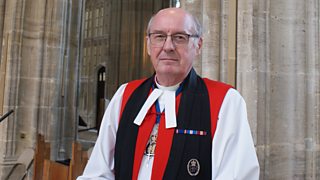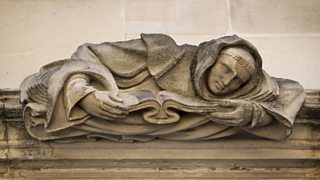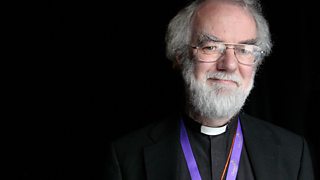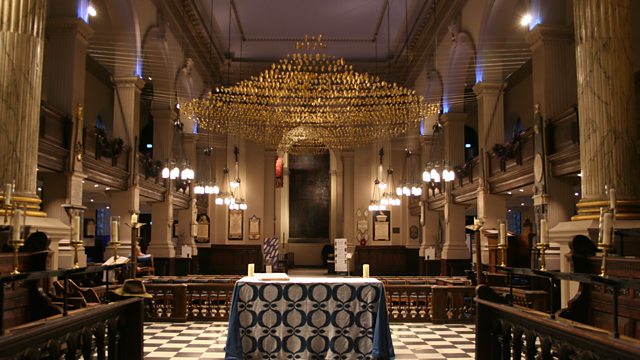
The Art of Faith
Ben Quash, Professor of Christianity & the Arts at King’s College London, leads a service reflecting on contemporary works of art in churches in the UK.
Ben Quash, Professor of Christianity & the Arts at King’s College London, leads a service reflecting on contemporary works of art in churches in the UK. He visits Guildford Baptist Church and explores the church's new Prayer Chapel Communion Table and Lectern, designed and created by Stephen Owen and winner of the 2019 Art and Christianity awards. He reflects on Tracey Emin’s For You, a pink neon sign written in the artist’s handwriting, with the words: ‘I felt you and I knew you loved me’, commissioned by Liverpool Cathedral as part of its contribution to Liverpool’s year as European Capital of Culture 2008. And he considers Jake Lever’s ‘Soul Boats’, a large scale installation commissioned to celebrate Birmingham Cathedral’s tercentenary. Producer Andrew Earis.
Music
1. Sospiri – Elgar
Academy of St Martin in the Fields
CD: Adagio – Classics for relaxation (Deutsche Grammophon)
2. Angel voices ever singing
CD: The Worship Collection Hymns (Clovercroft)
3. O nata lux – Morton Laurisden
Voces8
CD: Lux – Voces8 (Decca)
4. Blinded by your grace – Stormzy
The Kingdom Choir
CD: Stand by me – The Kingdom Choir (Sony)
5. Benedictus from ‘The Armed Man’ – Karl Jenkins
CD: Karl Jenkins – The Platinum Collection (EMI)
6. Be thou my vision
Jeff Victor & Rebecca Arons
CD: Amazing Grace hymns collection (Lifescapes)
7. Crucifixus – Lotti
Tenebrae
CD: Allegri – Miserere (Signum)
8. Sanctus – Will Todd
Tenebrae
CD: Will Todd – Lux et Veritas (Signum)
9. Come thou fount of every blessing
Jeff Victor & Rebecca Arons
CD: Amazing Grace hymns collection (Lifescapes)
10. Be still and know - Geoffrey Nobes
CD: Chants for Prayer (Kevin Mayhew)
Last on
More episodes
Reflections
To view images of the different art works, please click on 'The Art of Faith' gallery below.
��
For You – Tracey Emin (Liverpool Anglican Cathedral)
This pinkness is not subtle. It calls to mind the visual language of advertising, the entertainment industry, and the city – perhaps even those edgy urban spaces represented by the trailer park or the red light district.
Who is being spoken to? The word ‘You’ is capitalized in a way that recalls traditional ways of honouring God, but then so is every other word (except – interestingly - the personal pronoun ‘me’). The words are imaginable as a personal message in a Valentine’s Day card; they could easily be the speech of romantic or erotic love.
Might what we witness in the words of For You be the transformation of the language of erotic love to serve the expression of devotion to the divine? There’s a long Christian tradition of that, in interpretations of the Song of Songs for example.
And as the language of human love can offer a point of entry to articulation and expression of the love of God, so the installation of a work by an artist as well-known as Emin – who does not claim any moral or religious high-ground, and whose art often speaks from out of an intense vulnerability – might well act as its own sort of ‘entry point’ to a contemplation of God by those who would not normally cross the threshold of a place of worship. It is not just over a doorway, it is one. Its voice speaks the language of ‘outside’ and ‘inside’ simultaneously. The handwriting reinforces the sense that this is a real response from an actual human being, while the words chosen are not stilted, or off-puttingly pious; they convey a heartfelt response to something powerfully moving, and this is moving in its turn.
The verb ‘to feel’ can describe the result of your own action, or the result of someone else’s. You can feel someone by reaching out to touch them, as when the woman in the Gospels with unstoppable bleeding reaches out to touch the hem of Jesus’s garment, And you can feel someone because they touch you. Which is it here?
Both are possible, and this double possibility is heightened by the fact that you can read the words from left to right, like a sentence, or from the outer panels towards the centre, like a traditional painted triptych (a three-sectioned painting). For You has three units: ‘I Felt You’; ‘And I Knew’; You Loved Me’. If you read it like a sentence, the ‘I’ is the main agent, and ‘You Loved Me’ becomes the description of something that the ‘I’ has discovered. If you read this work like a triptych—towards the middle—something different happens. Another agency has makes itself felt. The ‘I’ of ‘I Felt You’ and the ‘You’ of ‘You Loved me’ meet. They meet in a moment of recognition. Perhaps even of faith. ‘And I Knew’.
��
Soul Boats – Jake Lever (Birmingham Cathedral)
Something you’ll see in many churches all over Europe and in Latin America – and especially those in a Catholic tradition – are what are called ‘ex-votos’. They are objects offered as tangible signs of prayers made and prayers heard. Sometimes they are the sculpted or moulded forms of body parts which have needed healing. Sometimes they are paintings. And in places near the coast they are often models of ships, whose perilous journeys called forth intense prayer for the safe return of cargoes and passengers.
These model ships were beautifully made by the hands of skilled artists, but they were also brought into being by the prayers of those who commissioned them, and invested their hopes and fears and gratitude in them. You will walk through many churches on the seaboards of the world and find such ships suspended above you.
I found echoes of these ex-votos in Jake Lever’s Soul Boats. Here too, the installation came to life in the confluence of the artist’s skill and the joys, sorrows, aspirations and petitions of a host of people. Walking beneath this flotilla you could see prayers in tangible form – even if you didn’t know their full back-story; even if you didn’t know just what cargo each had been invested with by those who wrote in them, decorated them, and launched them. But they were not lonely vessels. They were a fleet,�� showing something about the cathedral itself, as a place where a set of ‘I’s is transformed into a ‘We’.
For me, the whole installation, in its cathedral setting, worked like an icon. [Icons are more than painted boards showing the persons of Christ and the saints. As the designers of Orthodox churches will tell you, architectural spaces are icons too, coordinating light and movement and sound to communicate the presence of holiness in the here and now.
Soul Boats worked like an icon.] The gold card of its suspended vessels, like the gold ground of painted icons, was a reminder that heaven is not far off, and like a traditional iconostasis, or icon screen, it showed how many individuals can be bound together in a whole that is�� greater than its parts.��
St Paul wrote of how Christians have the treasure of their faith in earthen vessels. But he also talked of the glory for which we are being prepared, of a future when the things that make us most truly ourselves will be transformed for eternity. Yes, for now the gold of Christ may be on the inside, awaiting its disclosure. But Soul Boats helps us to imagine our earthy selves as golden vessels, like the holy ones shown in their heavenly state in traditional icons. Differentiated in a myriad ways, but gathered in glory.
��
Prayer Chapel Communion Table and Lectern - Stephen Owen (Guildford Baptist Church)
In the intimacy of this small Baptist Chapel in Guildford, Stephen Owen’s oak lectern and communion table take us on an upward journey.
The lectern has a huge nail driven diagonally through its base. The nail’s tip rests on the floor of the chapel—seeming almost to pierce the floor as well.
It’s a downward slant.
But like a tree that can outgrow its flesh wounds—incorporating what has penetrated it, wrapping it about with new growth—the lectern rises confidently upwards. It is tree-like, and for the same reason cross-like. And the horizontal arms that support the Scriptures also echo bird’s wings—and thus, subtly, the traditional iconography of so many eagle-shaped church lecterns.
So, then, far from being pinned to earth by the nail, the upward energy of this sculpted form suggests an unstoppable life that can allow God’s Word to take flight from it.
The communion table which stands next to the lectern bears an off-centre, circular hole in its base. If the lectern remains penetrated by the nail, the table is different. Whatever once penetrated it is no longer there. Perhaps this hole isn’t a wound at all. Or perhaps it is a unique kind of wound. Not the result of violence from outside, but the rupturing assertion of life from within. This circular hole evokes the open mouth of Christ’s tomb. If so, then the table suggests that in Christ’s resurrection the grave itself was wounded, as an immortal divine love drove its way outwards from inside its confining walls.
As we look at the table, are we being invited to explore this open wound and realize it not just as the mark of human cruelty but as the achievement of divine power? To see it as a passageway through which life and light are flowing towards us?
I’ve suggested that the table and the lectern can be contrasted with each other. But they also have something very striking in common. In both cases, the wood of their bases is rough, split and unfinished. This helps us to relate to them, for we too are split and unfinished. You can insert prayers in the gaps in the wood at the foot of the lectern, and in this way you can interact quite literally—through the roughness of the wood—with the one who chose to become like us: Jesus Christ.
But Christ became like us for a purpose. He became like us so as to change us into his perfect likeness. As they extend upwards, the wood of both objects becomes smoother and more finished. As we are to do. For God is working on us, in word and sacrament, in places of encounter like this little chapel—and is transforming us from one degree of glory to another.
��
Reflection – Ben Quash
What – in the 20th and 21st centuries - makes a work of art successful in a church space – and what counts as success?
The American art scholar Daniel Siedell writes that a great work of art – whether a poem in an anthology or a painting in a museum, seems to come to us from somewhere else.
All of the recent commissions in churches and cathedrals we’ve been reflecting on have this power to speak to us as though from somewhere else. Ordinary things – neon light, folded card, carved wood and painted surfaces – are made to speak an extraordinary language.
Think of how Tracey Emin’s For You seems to introduce a different culture into the cathedral. It may shock some people. But not all shock is bad. After all, there is shock but also exhilaration in a sudden gust of fresh air. For You is disruptive but not violent. It might be disconcerting, but it is sensitive to its context. The new artwork converses with the huge stained glass window above it. The conventional components of light and coloured glass – a time-honoured tradition of church decoration – are not contradicted but made new in neon.
So if the work’s readiness to sail so close to the wind is part the secret of its success, so is its ability to channel long traditions of devotion. And the same is true of the icon-like gold of Jake Lever’s ex-voto-like boats, and the ancient symbols in Graeme Mortimer Evelyn’s The Eternal Engine, and Stephen Owen’s eagle-cross and empty-tomb-altar in Guildford.
The capacity of contemporary works of art to challenge, to interrogate, to expose our attractions and revulsions, our kneejerk reactions and our gut instincts, can be a precious resource to those who seek to know God. For those are all things that Christ did too, as he preached in the market place, on the seashore and at the dinner table.
But like the ‘scribes trained for the kingdom of heaven’ whom Jesus talks about in Matthew’s Gospel (Matt 13:52) artists can bring out of their treasure both what is new and what is old. They can take us back to our foundations
Which is why, even as we find these works of art moving us transformatively towards the future, they at the same time help us reiterate the words that were said at the very beginning of creation: ‘It is good!’
��
Broadcast
- Sun 16 Feb 2020 08:10����ý Radio 4


